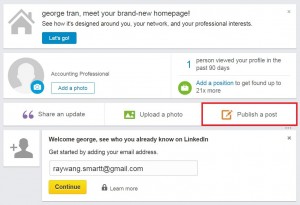On top of online paid advertising tactics such as Facebook ads and Google AdWords search marketing, PR is a powerful marketing approach that lets you reach your target audience and generate sales.
Here are three PR tactics you can use:
1. Publish articles on LinkedIn
As many of you may already know, LinkedIn lets its users write and publish content directly on LinkedIn using the Publish the post feature.
To use the feature, log in your account and simply click on Publish the post.

Once you’ve done so, you’ll be taken to a page where you can write a blog post.

• Articles published directly on LinkedIn receive more awareness from other users than articles shared via status updates. When a person publishes a LinkedIn article, LinkedIn shows a notification in the writer’s connections’ accounts, helping the LinkedIn post gain exposure.

Compare this to an article shared via a status update, which often get unnoticed due to the flood of content shared via statues LinkedIn daily.
• Articles published on LinkedIn get distributed on Pulse News, a RSS feed built in LinkedIn. This helps the article gain readership from LinkedIn users worldwide.
2. Gain online endorsements from influential social media users
An online endorsement could be a product review, Instagram post, or tweet about positive attributes of your brand or offerings.
By acquiring online endorsements from influential social media users, you can gain awareness in front of their fans, helping you improve online visibility and reputation.
To find influential social media users to seek endorsements from, use the following three tools:
• Tagboard. This tool lets you find social media posts that contain certain hashtags in the captions. You can use this tool to specifically find Instagram posts since Tagboard shows images associated with the hashtags so you can determine whether the images are relevant to your brand.
For example, if you’re a car dealership, you can use this tool to find car enthusiasts. Once you’ve discovered these users, nurture positive relationships with them and seek positive endorsements from them when opportunities arise.
To use Tagboard to find Instagram posts, enter a targeted keyword in the search box and the platform will generate relevant results.

Then, click on Filter on the left hand side and click on Instagram to only see Instagram posts.

• Followerwonk. This tool lets you find Twitter users who mention certain keywords in their bios or are located in certain geographic locations.
For example, if you’re a fashion retailer, you can use Followerwonk to find fashionistas in your city by searching for users who mention keywords such as “fashion” or “makeup” and the name of your
city such as New York.
To search for these users, enter the targeted keyword and city in the appropriate search boxes.

Once you’ve done so, Followerwonk will generate a list of relevant users.

• Google Advanced Blog Search. This Google search features lets you find blog posts relevant to your search queries. For example, if you’re a Johnson & Johnson, you can use Google Advanced Blog Search to find product reviews on a baby product launched by a competing brand.
To use Google Advanced Blog Search, first enter targeted keywords in the search engine.

Then, click on News > Search Tools > All news > Blogs.

Once you’ve taken these steps, Google will generate a list of relevant blogs. From there, you can find bloggers pertinent to your brand and industry, nurture rapports with them, and seek product reviews or other forms of online endorsements in the future.
3. Create coverage about events
Businesses today are like publishers; they create content about recent industry news to attract readers and remain on top of consumers’ minds. Similar to publishers, companies attend events and write articles about the events afterwards. This gives companies an opportunity to reach out to the event host and encourage them to share the article so the companies can increase online exposure.
In addition to paid advertising platforms such as Facebook ads and Google AdWords, traditional PR tactics such as relationship building and gaining mentions in articles remain an effective marketing tactic. In fact, with the large reach of social media, PR is now even more powerful in today’s business world.
By using the three PR techniques above, you can find relevant influential social media users and bloggers to gain endorsements from to boost your online visibility, increase brand reputation, and improve sales. If you want to suggest other PR techniques, please leave a comment in the comments section below!
This article was syndicated from Business 2 Community: 3 Easy Ways Small Businesses Can Use Social Media for PR
More Sales & Marketing articles from Business 2 Community:
- 10 Useful Sites All Marketers Should Save to Their Favorites Bars
- 4 Components of a B2B Content Marketing & Demand Gen Machine [PART 1]
- 6 Customer Experience Trends That Successful Retailers Are Taking Advantage of to Earn & Hold on to More Customers
- How to Build a Content Strategy
- What Do Marketers Really Want in Data and Technology?




